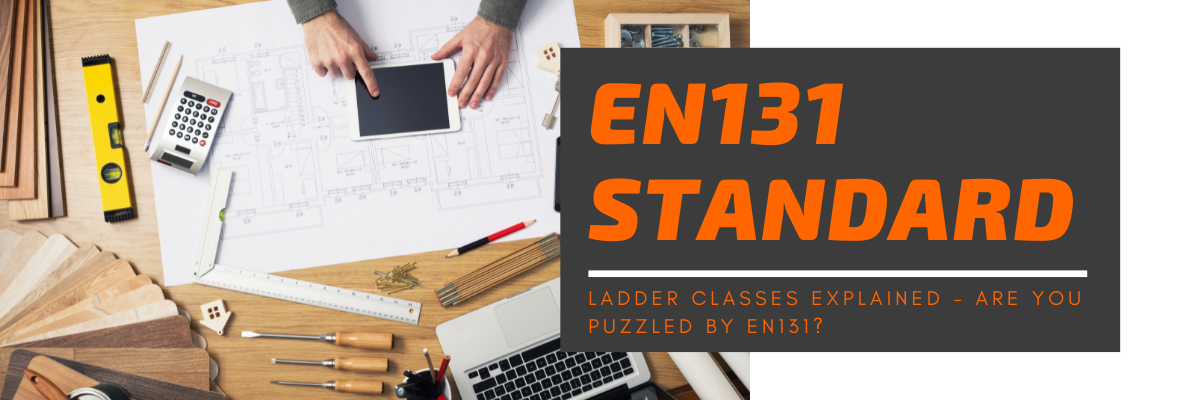Are you puzzled by EN131? If so not to worry, we have you covered. EN131 has recently changed and because of this change, it's made it really easy to explain. With a little help from our friends at Werner Ladders. We have all the information you need.
What is EN131 and how does it affect the UK?
EN131 is a European Union Certification for portable steps and ladders, manufactured from metal and certain other materials such as GRP. Anyone purchasing a ladder that is to the EN131 standard can have peace of mind it's been manufactured and tested to ensure maximum safety. EN131 does not cover warehouse steps, loft ladders (EN14975) or step stools (EN14183) as they have their own classification.
How Has EN131 Changed?
In the past, there were three different classifications of portable ladders, or step and extension ladders to you and me. These were Class 1 ladders, EN131 ladders and Class 3 ladders.
Class 1 ladders were used for industrial applications, often on construction sites and other heavy duty applications in harsher environments. EN131 was used for trade and retail, who needed a robust ladder, typically as a lighter weight for frequent tasks. Finally Class 3 was built with domesitc users in mind who use the ladder infrequently, for example to change a lightbulb. These three classifications have been withdrawn and there is now two, which does make things simpler:
- EN131 Professional - For industrial, trade & all business use
- EN131 Non-Professioal - For infrequent DIY tasks around the home
Ladder Testing - What's the difference?
The main noticeable difference when it comes to EN131 Professional and Non-Professional is unfortunately not a favourable choice for many consumers, but it's been done to keep you safe. Ladders over 3m now require a stabiliser bar at the bottom of the ladder, making the equipment wider and improving stability. The other changes to the standard are that both ladders are certified to a maxmimum load of 150kg.
The difference in the testing for Professional vs Non-Professional is the durability. Both classifications undergo similar testing, for example slip testing, torsion tests are the same, for durability a professional ladder must undergo 50,000 repetitions and Non-professional 10,000. Many users for ladders at home still purchase to the professional rating for a little extra piece of mind.
More Detail On New Ladder Classifications
EN131 Professional
This classification should be used for both industrial and trade use.
The EN131 professional standards are replacing class 1 but only for portable ladders, class 1 will still cover trestles. The maximum capacity is 150kg which is the same as the non-professional classification, however, the professional standard ladders have been tested 5 times more than a non-professional ladder.
EN131 Non-Professional
The EN131 non-professional standards will cover ladders for domestic use only. This classification is able to hold a 150kg load but the ladders within this classification are tested a little less vigorously. The EN131 Non-Professional certification replaces Class 3 ladders for domestic users only.
How will I know if a product is compliant with EN131?
Products will need to be independently tested and certified for compliance and labelled with the new EN131 Standard. If your product does not come with an EN131 label, it is highly likely not to be EN131. If you are in doubt request the certificate from the retailer. Believe it or not there are many non-compliant ladders on the market from both retailers and in well known supermarkets.
Do I need to purchase EN131 ladders?
There is no legal requirement to conform to standards in the UK but safety bodies such as Trading Standards and the HSE will expect manufacturers to comply. It is best practice to use new standard ladders, for the safety of yourself or your employees. Although there is no legal requirement buying to the correct standard is best practice and should an accident occur this will be one of the first questions from the HSE.
Do I need to retrain my staff?
Staff do not need to be retrained on the new standard, it is however recommended that they are made familiar with the changes and swap to the new standard once older equipment starts to fail inspections. Training is not a legal requirement, but again it is best practice of a responsible employer. The Working at Height regulations state that only a competent person should work from height, and completing a Ladder Association accredited training course is a good way to prove this, once completed this is valid for five years.
Further Information
If you are still unsure about any ladder classes or what class you need to purchase please don't hesitate to get in touch and speak to our expert team. You can email us via our contact form or give us a call on 01204 590 232
We have a wide range of step ladders and extension ladders that conform to the new classifications as mentioned above, should you be in the market for a new set of stepladders.

